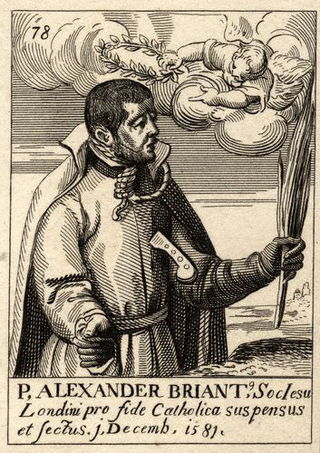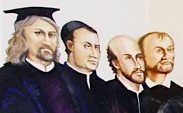Related Research Articles
Thomas Aufield, also called Thomas Alfield, was an English Roman Catholic martyr.
Robert Johnson, a Shropshire native, was a Catholic priest and martyr during the reign of Elizabeth I.

Alexander Briant was an English Jesuit and martyr, executed at Tyburn.
John Lowe (1553–1586) was an English Catholic priest and martyr.
Robert Dibdale was an English Catholic priest and martyr.
John Nelson was an English Jesuit martyr who was executed during the reign of Elizabeth I.
The Dryburne Martyrs: Richard Hill, Richard Holiday, John Hogg and Edmund Duke were English Roman Catholic priests and martyrs, executed at Dryburne, County Durham, in the reign of Elizabeth I. They were beatified by Pope John Paul II in 1987.

Roger Filcock was an English Jesuit priest. He was beatified as a Catholic martyr by Pope John Paul II on 22 November 1987.

Thomas Ford, a Devonshire native, was a Catholic martyr executed during the reign of Elizabeth I.

Luke Kirby was an English Catholic priest and martyr from the North of England, executed during the reign of Elizabeth I. He was is one of the Forty Martyrs of England and Wales.

Thomas Cottam was an English Catholic priest and martyr from Lancashire, who was executed during the reign of Elizabeth I.

Polydore Plasden (1563–1591) was one of the Catholic Forty Martyrs of England and Wales. A native of London, he studied for the priesthood at Rheims and Rome and was ordained in 1586 before being sent back to England soon after.
A priest hunter was a person who, acting on behalf of the English and later British government, spied on or captured Catholic priests during Penal Times. Priest hunters were effectively bounty hunters. Some were volunteers, experienced soldiers or former spies.
Robert Ludlam was an English priest, martyred in the reign of Queen Elizabeth I. He was born around 1551, in Derbyshire. His father was a yeoman. He matriculated at St John's College, Oxford, in 1575, and remained there for two or three years, but left without taking a degree. He was admitted to the English College at Rheims on 25 November 1580, and the following September, he was ordained as a priest. He set out for England on 30 April 1582.
Ralph Crockett was an English Roman Catholic priest. He is a Catholic martyr, beatified in 1929.

George Haydock was an English Roman Catholic priest. He is a Catholic martyr, beatified in 1987. He is not to be confused with his relative, also a priest, George Leo Haydock (1774–1849).

James Fenn was an English Catholic priest and martyr who was beatified on 15 December 1929, by Pope Pius XI. James Fenn was the brother of the Catholic priest and writer John Fenn and of Robert Fenn. All three brothers were choristers and scholars.

The Oaten Hill Martyrs were Catholic Martyrs who were executed by hanging, drawing and quartering at Oaten Hill, Canterbury, on 1 October 1588. The gallows had been put up in 1576. These four were beatified by Pope Pius XI in 1929.
Thomas Holford (1541–1588) was an English Protestant schoolteacher who became a Catholic priest during the reign of Queen Elizabeth I. He was martyred at Clerkenwell in London, and is recognised by the Catholic Church as having the status of Blessed.
Nicholas Woodfen born Nicholas Wheeler, also known as Nicholas Devereux, was an English Roman Catholic priest who was hanged, drawn and quartered at Tyburn, London on 21 January 1586. He is considered a Catholic martyr and one of the Eighty-five martyrs of England and Wales who were executed between 1584 and 1679. He was beatified on 22 November 1987 by Pope John Paul II.
References
- ↑ "Blessed Robert Johnson", Diocese of Shrewsbury
- 1 2 Wainewright, John. "Blessed John Shert." The Catholic Encyclopedia. Vol. 14. New York: Robert Appleton Company, 1912. 5 Feb. 2013
- ↑ "Blessed John Shert", the One Hundred and Five Martyrs of Tyburn, Burns & Oates, Ltd., London, 1917
- 1 2 3 ""Blessed John Shert", Diocese of Shrewsbury". Archived from the original on 2013-01-24. Retrieved 2013-02-06.
- ↑ Camm, Bede. Lives of the English Martyrs Declared Blessed by Pope Leo XIII in 1886 and 1895: Martyrs under Queen Elizabeth, Burns and Oates, 1905, p. 460
 This article incorporates text from this source, which is in the public domain .
This article incorporates text from this source, which is in the public domain .